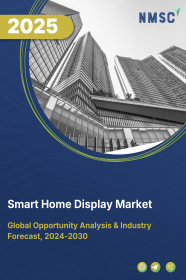
Additive Manufacturing Market by Type (Desktop 3D Printer, and Industrial 3D Printer), by Technology (Stereolithography, Fused Deposition Modeling, Selective Laser Sintering, Direct Metal Laser Sintering, Polyjet Printing, Inkjet Printing, Electron Beam Melting, Laser Metal Deposition, Digital Light Processing, Laminated Object Manufacturing, and Other Technology), by Component (Hardware, Software, and Services), and Others – Global Opportunity Analysis and Industry Forecast, 2024–2030
Industry: Semiconductor & Electronics | Publish Date: 14-Feb-2025 | No of Pages: 672 | No. of Tables: 507 | No. of Figures: 480 | Format: PDF | Report Code : SE500
US Tariff Impact on Additive Manufacturing (AM) Market
Trump Tariffs Are Reshaping Global Business
Market Overview
The global Additive Manufacturing (AM) Market size was valued at USD 20.51 billion in 2023 and is projected to reach USD 83.13 billion by 2030, at a CAGR of 20.6% from 2024–2030. In terms of volume the market size was 1017.82 thousand units in 2023 and is projected to reach 4868.68 thousand units in 2030, with a CAGR of 22.9% from 2024 to 2030.
Additive manufacturing, also known as additive layer manufacturing (ALM) or three-dimensional (3D) printing, is a computer-controlled process that creates 3D objects by depositing materials, usually in layers.
Additive manufacturing uses data, computer-aided design (CAD) software or 3D object scanners to direct hardware for depositing materials layer upon layer, in precise geometric shapes. In order to create an object using additive manufacturing, a design must be created first. This is typically done using CAD software, or by taking a scan of the object, which is to be printed. Then the design is translated by software into a layer-by-layer framework for the additive manufacturing machine to follow.
The framework is sent to the 3D printer, which begins creating the object immediately. The actual process of additive manufacturing can be done in a number of ways, which can take from several hours to several days, depending on the object’s size.
Growing Adoption of 3D Printing in the Healthcare Industry
The rising application of 3D digital printing in the healthcare sector to create prostheses, implants, and generate accurate prototypes of medical devices fuels the growth of the market. Further, 3D-printed models allow surgeons to practice complex surgical procedures on lifelike models and they can improve their accuracy and speed of operation.
Moreover, 3D printing technology is being used to create implants that are unique to each patient. Other additive manufacturing applications include surgical cutting and drilling equipment, prosthetics, artificial organs, and designer pharmaceuticals which are designed by additive manufacturing technologies. For instance, in October 2021, Henkel launched a new class of 3D printing resins for healthcare applications under its leading Loctite brand. Henkel 3D printing resins are created and produced in compliance with ISO 13485 quality management standards to ensure uniformity in the design, development, production, and delivery of medical devices.
High Adoption of 3D Printing in the Automotive Sector:
Additive manufacturing is rapidly gaining ground in the automotive sector across the world, as 3D printing makes it possible to create highly detailed and accurate scale models for design and concept demonstration. It is also used to prototype physical parts such as interior elements of vehicles, and create custom, complex, and high-performance parts.
Further, 3D printing in the automotive sector helps original equipment manufacturers (OEMs) to reduce costs and produce cost-effective automobile parts, which increases the demand for additive manufacturing across the world.
In addition, industry leaders such as Stratasys (Israel), 3D Systems (US), and Porsche are investing in 3D printing technology, to introduce new and innovative technologies in the automotive sector further driving the growth of the market. In 2020, Porsche introduced its 3D-printed seats that can be customized to the specifications and requirements of the customer. 3D printing helped the company to produce the seats considering the customer’s body contours.
Lack of Standardization of Equipment to Impede the 3D Printing Market Growth
The primary challenge faced by the key players in the 3D printing industry is the lack of standardized equipment and process. This is expected to create difficulties in terms of quality control and production costs. Manufacturers have to invest in expensive machines and software in order to ensure consistency in quality. This is attributed to the conventional mindset of the manufacturers that are holding to their misconception about prototyping, instead of realizing the benefits associated with AM. This factor restrains the growth of the market.
Advances in Technology Creates an Opportunity for Upcoming Years
Industry experts and researchers are pursuing aggressive research and development (R&D) activities to create opportunities for several other efficient and reliable technologies. The introduction of 3D printers that can create prototypes of electronic components such as 3D printed circuit boards (PCBs), antennae, capacitors, and sensors reduce manufacturing costs, which in turn is expected to create lucrative growth opportunities for the market players in coming years.
North America is Projected to Hold the Largest Share of AM Market
North America dominates the global additive manufacturing industry and is expected to remain dominant in the market throughout the forecast period. The presence of a large number of automotive, construction, aerospace, and defence industry using 3D printing technology in the manufacturing process boosts the market growth in the region.
Further, high healthcare investment in this region enables healthcare providers to adopt cutting-edge technologies such as 3D digital printing for patient-specific surgical models, affordable prostheses, and dental implants. For instance, in November 2019, 3D Systems received clearance from the U.S. Food and Drug Administration (FDA) for its dental 3D printing material called Denture 3D+ and dental 3D printer NextDent 5100.
Moreover, the presence of a large number of pharmaceutical companies that allows them to produce new surgical cutting and drill guides, prosthetics, and patient-specific copies of bones, organs, and blood arteries via 3D printing propels the growth of the market. For instance, in November 2021, in Singapore, the National University Hospital (NUH) announced collaboration with Johnson & Johnson (J&J) in hospital to launch a 3D Printing Point of Care lab for improving patient care capability and enhancing personalized healthcare. The Singapore Economic Development Board (EDB) supported this initiative to accelerate healthcare innovation in Singapore.
In addition, the presence of several key market players such as Protolabs, Xometry Inc., Stratasys Ltd., and Velo3D Inc. in the region adopting various strategies including product launches and acquisitions propels the growth of the market. For instance, in January 2022, Protolabs launched a post-processing technology called vapor smoothing for 3D printed production parts. Vapor smoothing can enhance the finishing of 3D printed parts including complex geometries.
Europe Witnessed Substantial Growth in the Global AM Market
Europe shows a substantial growth in the global additive manufacturing market due to the rising adoption of AM devices across industries such as automotive, health, and others due to the presence of 3D printing start-ups in Germany providing a wide range of 3D industrial printers. For instance, in December 2020, German start-up iFactory3D launched a 3D printing device which is a 4-in-1 3D printer for residential use and is characterized by an automatic working process.
Further, the growing use of additive manufacturing technology in the defence industry owing to rising government initiatives for developing 3D printing applications for the military drives the growth of the market. For instance, in October 2022, the UK’s Ministry of Defence (MOD) announced the launch of project TAMPA, a seven-year-long program to increase the amount of 3D printed parts purchased by the UK military.
Competitive Landscape
Additive manufacturing industry include various market players such as HP Inc., Colibrium Additive (GE Aerospace), EOS GmbH, Stratasys, Trumpf, 3D Systems, Inc., Formlabs, ,Desktop Metal Inc., DMG Mori AG, Proto Labs, Inc. These market players are adopting various strategies including partnership and product launch to maintain their dominance in the market.
For instance, in September 2022, Stratasys announced a partnership with Evonik as a new additive manufacturing materials partner. This partnership aims to bring Evonik’s expertise in the development and manufacturing of ready-to-use photopolymer materials to the P3 platform. Through this partnership among two big companies, customer will be benefited with more better and advanced products in upcoming days.
Also, in June 2022, Velo3D launched its latest industrial additive manufacturing system ‘Sapphire XC 1MZ’. This product has a faster proprietary non-contact recoater that guarantees a lack of part collision, protecting both the printed build and the recoater while slashing the downtime between layers.
Additive Manufacturing Market Key Segments
By Type
-
Desktop 3D Printer
-
Industrial 3D Printer
By Technology
-
Stereolithography
-
Fused Deposition Modeling
-
Selective Laser Sintering
-
Direct Metal Laser Sintering
-
Polyjet Printing
-
Inkjet Printing
-
Electron Beam Melting
-
Laser Metal Deposition
-
Digital Light Processing
-
Laminated Object Manufacturing
-
Other Technology
By Component
-
Hardware
-
Software
-
Design Software
-
Inspection Software
-
Printer Software
-
Scanning Software
-
-
Services
By Application
-
Prototyping
-
Tooling
-
Functional Parts
By End-User
-
Desktop Additive Manufacturing
-
Educational Purpose
-
Fashion & Jewelry
-
Objects
-
Dental
-
Food
-
Other Desktop Additive Manufacturing
-
-
Industrial Additive Manufacturing
-
Automotive
-
Aerospace & Defense
-
Healthcare
-
Consumer Electronics
-
Power & Energy
-
Other Industrial Additive Manufacturing
-
By Geography
-
North America
-
The U.S.
-
Canada
-
Mexico
-
-
Europe
-
The UK
-
Germany
-
France
-
Italy
-
Spain
-
Denmark
-
Netherlands
-
Finland
-
Sweden
-
Norway
-
Russia
-
Rest of Europe
-
-
Asia-Pacific
-
China
-
Japan
-
India
-
South Korea
-
Australia
-
Indonesia
-
Singapore
-
Taiwan
-
Thailand
-
Rest of Asia Pacific
-
-
Rest of World
-
Latin America
-
Middle East
-
Africa
-
Report Scope and Segmentation
|
Parameters |
Details |
|
Market Size in 2023 |
USD 20.51 Billion |
|
Revenue Forecast in 2030 |
USD 83.13 Billion |
|
Growth Rate |
CAGR of 20.6% from 2023 to 2030 |
|
Analysis Period |
2023–2030 |
|
Base Year Considered |
2023 |
|
Forecast Period |
2024–2030 |
|
Market Size Estimation |
Billion (USD) |
|
Growth Factors |
Growing adoption of 3D printing in the healthcare industry |
|
Countries Covered |
26 |
|
Companies Profiled |
10 |
|
Market Share |
Available for 10 companies |
|
Customization Scope |
Free customization (equivalent up to 80 analysts working hours) after purchase. Addition or alteration to country, regional & segment scope. |
|
Pricing and Purchase Options |
Avail customized purchase options to meet your exact research needs. |
Key Players
-
HP Inc.
-
Colibrium Additive (GE Aerospace)
-
EOS GmbH
-
Stratasys
-
Trumpf
-
3D Systems, Inc.
-
Formlabs
-
Desktop Metal Inc.
-
DMG Mori AG
-
Proto Labs, Inc.

















 Speak to Our Analyst
Speak to Our Analyst



















